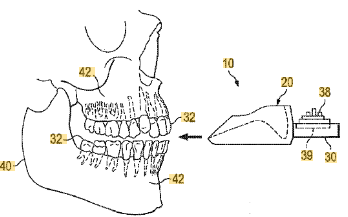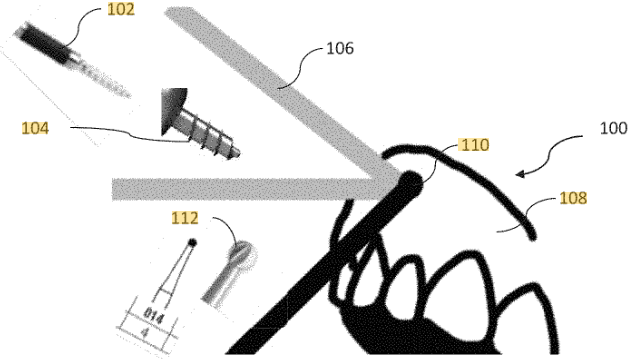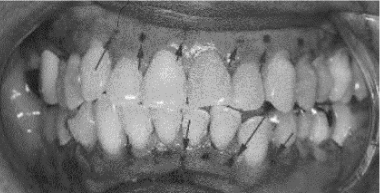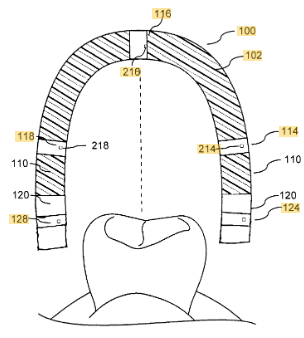Services


Trademark Search
and Clearance
Search Onlineand Clearance

Leading IP Firm
Our ratings
This article analyzes breakthrough technologies used in dentistry and orthodontics around the world. As you know, dentistry is one of the fastest growing areas of medicine, which constantly patents innovative technical solutions that allow people to undergo treatment more comfortably and painlessly.
Orthodontics
Correction of the bite is achieved through the use of mechanical static forces that cause bone remodeling, which allows the teeth to move. This widespread approach to treating malocclusion takes an average of about 24 months, using orthodontic braces consisting of a wire that applies a constant static force to the junction of teeth with braces attached to each tooth. Clinical malocclusions include malocclusion, crossbite, open bite, and crooked teeth for both aesthetic and functional or structural reasons. Removable transparent devices (aligners) for dental treatment are also widely known.
Removable appliances, as well as traditional components of orthodontic systems, such as dental braces and wires, are disposable. At the first visit, during a procedure known as bonding, orthodontic braces are attached to the teeth with cement or some similar substance with adhesive properties. Except in cases of damage or loss of braces, the same braces are retained throughout the course of treatment. At the end of treatment, orthodontic braces are removed. The wires are usually changed during corrective visits as needed. The previous archwire is discarded each time a new one is attached to the brackets. The cost of consumables is the responsibility of the patient each time.
In addition, orthodontic treatment with braces can be complicated by the fact that it often causes discomfort and pain to patients, including initial placement and adjustments between visits. Post-treatment stability and tissue integrity are also important factors associated with orthodontic treatment. Stability is usually achieved and improved by wearing retainers continuously, in many cases indefinitely. Failure to comply with the wearing regimen of retainers can lead to relapses requiring additional treatment.
Proposed by the American “Association for Advanced Orthodontics and Education”, an innovative system for correcting malocclusion, disclosed in the application for invention US 20200405444 A1, published on December 31, 2020, for which a positive decision on the issuance of a patent is expected soon, allows you to correct the bite and change the position of the teeth without retainers, pain and discomfort in three to six months, while putting on the system only at night.
The proposed system of orthodontic remodeling includes an extra-oral vibration source connected to the bite block, while the extra-oral vibration source drives the bite block to vibrate with a frequency in the range from 0.1 to 400 Hz. The bite block is designed to transmit cyclic forces simultaneously to the teeth of the maxillary and mandibular arches, and the bite block and the extraoral vibration source are held during use only due to clamping by the teeth. The battery is designed to power the extraoral vibration source, and the processor is configured to control the extraoral vibration source. Electronic media may collect data indicating duration and frequency of use so that patient compliance can be determined.
Thus, constant vibration quickly forces the teeth to line up in the form of a cap, while the patient does not experience pain and discomfort, without interfering with their sleep at night.
Correction of the curvature of the teeth and, as a result, the bite occurs due to the restructuring of the periodontal ligament between the teeth and bone tissue, while there is no collapse of small vessels (capillaries), as occurs when installing braces, due to which the cells that provide blood flow to the teeth are not released, and the mechanism of natural tissue regeneration does not start, which slows down the process of teeth alignment.

US patent 11173014 B2, published on 11/16/2021, protected another breakthrough technical solution in the field of orthodontics - a minimally invasive way to increase the speed of tooth movement (“BAST” technology).
If an adult decides to move their teeth for any reason, the speed at which they can move safely is so slow that treatment can take years. In turn, given the slow speed of movement, adult teeth tend to return to their previous, sedentary or other undesirable position after they have been moved with braces or aligners.
This unwanted result can occur even if the retainer is worn or attached to multiple teeth.
It is also now accepted that dental implants, once placed in the mouth, cannot be moved.
In addition, in some patients, the tooth may usually be more parallel to the plane of the jaw than perpendicular, and may not erupt at all because it does not grow to the gingival surface.
Often, the treatment in these cases consists of the surgical removal of the tooth by cutting the gums and removing the tooth, sometimes part of the bone, with dental forceps. The prevailing opinion is based on the belief that unerupted or partially impacted teeth cannot function in the dentition.
The method proposed in the present invention solves the above problems.
A method for increasing the speed of at least one moving tooth along the jaw bone includes placing an abrasive bur of the desired diameter between adjacent roots of at least one tooth in the jaw bone, the abrasive bur is rotated using a manual device to penetrate the gum tissue covering the space between adjacent roots of at least one tooth in the jaw to remove the desired amount of gum tissue and expose the underlying jawbone, and to bring the bone into contact with a rotating burr to abrasively vibrate the jawbone adjacent to at least one tooth without drilling into the cortical bone.
The claimed method provides an opportunity to restore the teeth so that they correspond more to the desired or ideal sizes, as well as to reduce the time required to achieve a stable and lasting result.
Figure 2 and Figure 3 illustrates the “BAST” technique performed on the gum and bone of a real patient in accordance with an embodiment of the claimed invention.


Prevention in dentistry
Another progressive technical solution is the use of ozone for the treatment of a prepared carious cavity, including teeth whitening.
Recently, ozone therapy has become a new alternative, atraumatic therapeutic method in medicine and dentistry. Ozone, which is a triatomic particle of oxygen (O3), is negatively charged and is a natural oxidizing agent. Bad cells in our body, such as bacteria, viruses, and cancer cells, are usually positively charged and do not have antioxidants on their cell membranes, so they attract ozone particles that destroy them. Dentistry uses a stream of liquid ozone (ozonated water) or ozone gas that is delivered to the teeth and gums for 30 minutes to treat periodontal disease by flushing below the gum line with ozonated water. Ozone is also used in both liquid and gaseous form in root canal treatments, to kill bacteria, sterilize the canal system, and promote healing. As a gas, ozone can get into places in the mouth that are inaccessible to liquids. This is because the gas can enter tiny tubules that cannot otherwise be accessed, thereby providing a truly sterile, bacteria-free root canal system prior to canal filling.
From US patent 9539076 B2, published on January 10, 2017, an apparatus and system for conducting two-level oxidative therapy in dentistry is known. The device is a mouthpiece made of rubber or thermoplastic elastomer, which provides full or partial coverage of the treated teeth and gums, first with hydrogen peroxide vapor, and then with ozone gas. The design of the mouthpiece, which includes several injection tubes, which allows you to treat all surfaces of all teeth and gums at the same time, thereby providing a fast, painless and economical procedure for the patient.
The therapy of the present invention includes biofilm cleansing (removal of bacterial pathogens), periodontal pocket disinfection and bone disinfection, caries prevention, endodontic treatment, tooth extraction, tooth sensitivity, temporomandibular joint treatment, gingival recession (exposed root surfaces), root canal treatment, pain relief, infection control, accelerated healing, tissue regeneration, bad breath control, tooth surface remineralization and whitening.


Dental materials (“Liquid filling”)
English company “Lucite International Speciality Polymers and Rubbers Limited” proposed a curing multicomponent acrylic composition, for which a patent for the invention RU 2712216 C2 was issued in the Russian Federation, published on January 27, 2020.
The invention includes a solid first part and a storage-stable liquid second part, which parts are intended to form a cement which, when stirred, solidifies to form a solid mass. The composition further includes an acrylic monomeric component in the second part, an initiating component, a first subset of acrylic polymer granules in the first part, a second subset of emulsionpolymerized acrylic microparticles in the first part, and a radiopaque filler, wherein the radiopaque filler is encapsulated in bulk and/or adsorbed on the acrylic polymer granules. The first subset and at least 90% of all acrylic polymer beads with encapsulated and/or adsorbed radiopaque filler of the first subset are present in the first part of the composition.
The advantage is that room temperature curing compositions (so-called “ self -curing systems” or “cold cure systems” have a setting time which is determined by the rate at which the viscosity of the composition containing solid and liquid components begins to increase immediately after mixing, and is controlled by a number of factors such as the particle size and shape of the granulated polymer, the molecular weight of the polymer, and the composition of the polymer.
Radiopaque fillers are a necessary ingredient that is added to the composition for it to function as a radiopaque agent that shows the position of the cement when implanted into the body.
Dental applications of the claimed composition, in addition to fillings for restoring teeth, include denture bases, denture base plates, denture liners, denture repair materials, custom trays, crown and bridge veneering, artificial teeth, veneers, and materials for treating natural teeth.
“Growing” a new healthy tooth
Japanese developers have proposed a technology for the manufacture of restorative material used to restore the area of a lost tooth in the oral cavity. This technology is protected, including in the Russian Federation, by patent RU 2521195 C2, published on June 27, 2014. To do this, the first cell mass formed by cells or a cell from mesenchymal or epithelial cells and the second cell mass formed by another cell or other cells from mesenchymal or epithelial cells are placed on the carrier. In this case, one of the mesenchymal or epithelial cells is obtained from the tooth germ and these cell masses are placed in close contact with each other without mixing. These cell masses are grown with the formation of a whole restored tooth or its germ. Then, the orientation of the whole restored tooth or its germ formed by growing is determined, which allows the implantation of the whole restored tooth or its germ in the area of the lost tooth so that the coronal part of the tooth is directed inside the oral cavity, while the tooth germ or tooth is used as a restorative material to obtain the equivalent of a lost tooth in the area of a lost tooth. This group of inventions makes it possible to restore the area of a lost tooth by introducing a restored tooth germ or a restored whole tooth, manufactured by the above method.
Originally published in Patent Lawyer Magazine